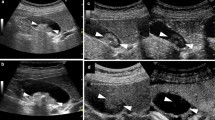Abstract
Background
Transabdominal ultrasonography (TAUS) is the most commonly used modality to diagnose gallbladder (GB) disease. GB polyps are reported in 1–5.6 % of TAUS studies. Histopathologic studies suggest that there is a relationship between GB polyps and GB cancer. Previous literature suggests GB polyps reported on TAUS do not correlate well with histological findings. There have been recent advances in TAUS technology. We hypothesize the recent advances in TAUS technology have improved the accuracy of TAUS for diagnosing GB polyps.
Methods
Radiology and pathology databases at our tertiary care center were retrospectively searched between January 1, 2000, and December 31, 2010. Ultrasound reports that suggested a GB polyp was present on TAUS were correlated to histopathology in cases where a cholecystectomy was performed. The pathology reports where a GB polyp was found were correlated with preoperative TAUS reports.
Results
There were 102,740 TAUS reports referring to the GB, of which 6,612 (6.4 %) contained search terms suggesting a GB polyp was present. There were 13,278 cholecystectomy pathology reports, of which 159 (1.2 %) included a diagnosis of GB polyp. TAUS detected only 50 % of the polyps identified on histopathology. The sensitivity and specificity of TAUS for diagnosing GB polyps were 50.0 and 98.3 %, respectively. The positive and negative predictive values were 10.5 and 99.8 %.
Conclusions
Despite improvement in TAUS technology, the accuracy for GB polyps remains poor. This needs to be considered when managing patients with TAUS-detected GB polyps. We recommend that the decision to operate on TAUS-detected GB polyps be largely based on symptoms, and following GB polyps with TAUS should be discouraged.

Similar content being viewed by others
References
Kratzer W, Haenle MM, Voegtle A, Mason RA, Akinli AS, Hirschbuehl K et al (2008) Ultrasonographically detected gallbladder polyps: a reason for concern? A seven-year follow-up study. BMC Gastroenterol 8:41
Okamoto M, Okamoto H, Kitahara F, Kobayashi K, Karikome K, Miura K et al (1999) Ultrasonographic evidence of association of polyps and stones with gallbladder cancer. Am J Gastroenterol 94(2):446–450
Kozuka S, Tsubone N, Yasui A, Hachisuka K (1982) Relation of adenoma to carcinoma in the gallbladder. Cancer 50(10):2226–2234
Aldridge MC, Bismuth H (1990) Gallbladder cancer: the polyp-cancer sequence. Br J Surg 77(4):363–364
Marangoni G, Hakeem A, Toogood GJ, Lodge JP, Prasad KR (2012) Treatment and surveillance of polypoid lesions of the gallbladder in the United Kingdom. HPB, Oxford
Damore LJ 2nd, Cook CH, Fernandez KL, Cunningham J, Ellison EC, Melvin WS (2001) Ultrasonography incorrectly diagnoses gallbladder polyps. Surg Laparosc Endosc Percutan Tech 11(2):88–91
Chattopadhyay D, Lochan R, Balupuri S, Gopinath BR, Wynne KS (2005) Outcome of gall bladder polypoidal lesions detected by transabdominal ultrasound scanning: a nine year experience. World J Gastroenterol 11(14):2171–2173
Zielinski MD, Atwell TD, Davis PW, Kendrick ML, Que FG (2009) Comparison of surgically resected polypoid lesions of the gallbladder to their pre-operative ultrasound characteristics. J Gastrointest Surg 13(1):19–25
Spaziani E, Di Filippo A, Picchio M, Lucarelli P, Pattaro G, De Angelis F, Francioni P, Vestri A, Petrozza V, Narilli F, Drudi F M, Stagnitti F (2013) Prevalence of adenoma of gallbladder, ultrasonographic and histological assessment in a retrospective series of 450 cholecystectomy. Ann Ital Chir 84:159–164
Corwin MT, Siewert B, Sheiman RG, Kane RA (2011) Incidentally detected gallbladder polyps: is follow-up necessary? Long-term clinical and US analysis of 346 patients. Radiology 258(1):277–282
Csendes A, Burgos AM, Csendes P, Smok G, Rojas J (2001) Late follow-up of polypoid lesions of the gallbladder smaller than 10 mm. Ann Surg 234(5):657–660
Ansari SM, Banu S, Awal MA, Siddique AB, Alam MM (2007) Polypoid gall bladder lesions: is it necessary for immediate surgery? Bangladesh Med Res Counc Bull 33(2):44–47
Matos AS, Baptista HN, Pinheiro C, Martinho F (2010) Gallbladder polyps: how should they be treated and when? Rev Assoc Med Bras 56(3):318–321
Andrén-Sandberg AN (2012) Diagnosis and management of gallbladder polyps. Am J Med Sci 4(5):203–211
Akatsu T, Aiura K, Shimazu M, Ueda M, Wakabayashi G, Tanabe M et al (2006) Can endoscopic ultrasonography differentiate nonneoplastic from neoplastic gallbladder polyps? Dig Dis Sci 51(2):416–421
Choi WB, Lee SK, Kim MH, Seo DW, Kim HJ, Kim DI et al (2000) A new strategy to predict the neoplastic polyps of the gallbladder based on a scoring system using EUS. Gastrointest Endoscop 52(3):372–379
Sun XJ, Shi JS, Han Y, Wang JS, Ren H (2004) Diagnosis and treatment of polypoid lesions of the gallbladder: report of 194 cases. Hepatobiliary Pancreat Dis Int 3(4):591–594
Jang JY, Kim SW, Lee SE, Hwang DW, Kim EJ, Lee JY et al (2009) Differential diagnostic and staging accuracies of high resolution ultrasonography, endoscopic ultrasonography, and multidetector computed tomography for gallbladder polypoid lesions and gallbladder cancer. Ann Surg 250(6):943–949
Lee J, Yun M, Kim KS, Lee JD, Kim CK (2012) Risk stratification of gallbladder polyps (1–2 cm) for surgical intervention with 18F-FDG PET/CT. J Nucl Med 53(3):353–358
Acknowledgments
The authors thank Dorrell Metcalfe and Ellen Hatt for their help with accessing the radiology and pathology databases at the CDHA.
Disclosures
Drs. Daniel French, Philippe Allen, and James Ellsmere have no conflicts of interest or financial ties to disclose.
Funding
There was no funding provided for this research.
Author information
Authors and Affiliations
Corresponding author
Additional information
Presented at the SAGES 2013 Annual Meeting, April 17–20, 2013, Baltimore, MD.
Rights and permissions
About this article
Cite this article
French, D.G., Allen, P.D. & Ellsmere, J.C. The diagnostic accuracy of transabdominal ultrasonography needs to be considered when managing gallbladder polyps. Surg Endosc 27, 4021–4025 (2013). https://doi.org/10.1007/s00464-013-3033-1
Received:
Accepted:
Published:
Issue Date:
DOI: https://doi.org/10.1007/s00464-013-3033-1




